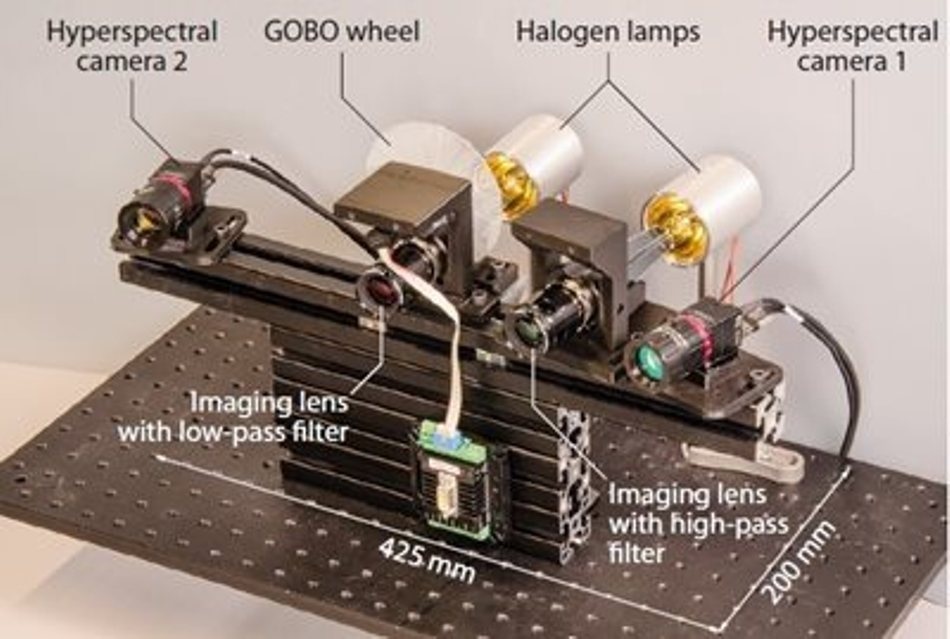Aug 29 2018
Scientists have created a compact imaging system with the ability to measure the shape and light-reflection characteristics of objects with high accuracy and speed. This 5D hyperspectral imaging system, which has been named so as it captures multiple wavelengths of light together with spatial coordinates as a function of time, could be advantageous for a range of applications such as identifying people in secure areas of airports and optical-based sorting of products. Further miniaturization of the imager could allow smartphone-based testing of fruit ripeness, or personal medical monitoring.
 The new hyperspectral imager contains two cameras and measures just 425 by 200 millimeters. With further miniaturization, it could be incorporated into smartphones for personal use. (Image credit: Stefan Heist, Friedrich Schiller University/Fraunhofer IOF)
The new hyperspectral imager contains two cameras and measures just 425 by 200 millimeters. With further miniaturization, it could be incorporated into smartphones for personal use. (Image credit: Stefan Heist, Friedrich Schiller University/Fraunhofer IOF)
What’s more, “because our imaging system doesn’t require contact with the object, it can be used to record historically valuable artifacts or artwork,” stated research group leader Stefan Heist of Friedrich Schiller University Jena and Fraunhofer Institute for Applied Optics and Precision Engineering, Germany. He added that this can be employed to develop a detailed and precise digital archive, while also enabling the investigation of the material composition of the object.
In the place of just three colors detected by normal cameras, hyperspectral imagers have the ability to detect dozens to hundreds of colors, or wavelengths. In a conventional hyperspectral image, each pixel includes wavelength-dependent radiation intensity over a particular range connected to two-dimensional coordinates.
The new hyperspectral imaging system, created in partnership with Gunther Notni’s research team from Germany’s Ilmenau University of Technology, progresses this imaging strategy by obtaining additional dimension information. In The Optical Society (OSA) journal Optics Express, scientists have described the way each pixel obtained by the innovative 5D hyperspectral imager includes the time—x, y, and z spatial coordinates—and information based on light reflectance ranging from the visible to the near-infrared region of the electromagnetic spectrum.
“State-of-the-art systems that aim to determine both the shape of the objects and their spectral properties are based on multiple sensors, offer low accuracy or require long measurement times,” stated Heist. “In contrast, our approach combines excellent spatial and spectral resolution, great depth accuracy and high frame rates in a single compact system.”
Creating a Compact Prototype
The scientists developed a prototype system with a footprint of just 200 x 425 mm, which is about the size of a laptop. It contains two hyperspectral snapshot cameras that form 3D images and acquire depth information quite similar to what our eyes do by capturing a scene from two slightly different directions. A complete set of data points in space for an object can be developed by identifying specific points on the surface of the object, which are present in both camera views. Yet, this strategy holds good only if the object has adequate texture or structure for unambiguous identification of points.
The team integrated a specially developed high-speed projector into the system to capture the spectral information as well as the surface shape of objects that may not be highly structured or texturized. A mechanical projection technique is employed for using a series of aperiodic light patterns to artificially texture the object surface. This enables accurate and powerful 3D reconstruction of the surface. Then, the spectral information acquired by the different channels of the hyperspectral cameras are mapped onto these points.
“Our earlier development of a system projecting aperiodic patterns by a rotating wheel made it possible to project pattern sequences at potentially very high frame rates and outside the visible spectral range,” stated Heist. “New hyperspectral snapshot cameras were also an important component because they allow spatially and spectrally resolved information to be captured in a single image, without any scanning.”
High-Speed Hyperspectral Imaging
The scientists characterized their prototype by examining the spectral behavior of the cameras as well as the 3D performance of the whole system. They demonstrated that it has the ability to capture visible to near-infrared 5D images as rapid as 17 frames per second, considerably faster than other similar systems.
The researchers demonstrated the advantages of the prototype to examine culturally significant objects by using it to digitally document a historical relief globe from 1885. They also developed near-infrared 5D models of a person’s hand and proved that the system had the ability to be used as a simple device for detecting veins. It is also possible to use the imager for agricultural applications, which was demonstrated by using it to capture the 5D change in the reflection spectrum of citrus plant leaves while absorbing water.
The aim of the scientists is to enhance the prototype by employing hyperspectral cameras that have a higher signal-to-noise ratio or that exhibit less crosstalk between the various spectral channels. The system would be customized to suit particular applications. For instance, cameras with high imaging rates could be employed to examine dynamically changing object properties, and sensors that have high resolution in the infrared wavelength can be used to detect chemical leaks.